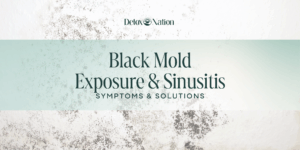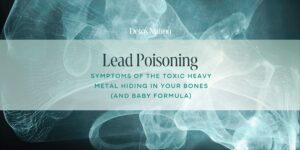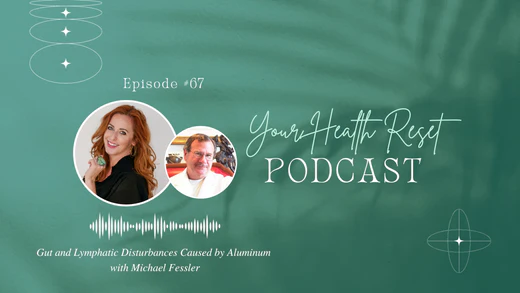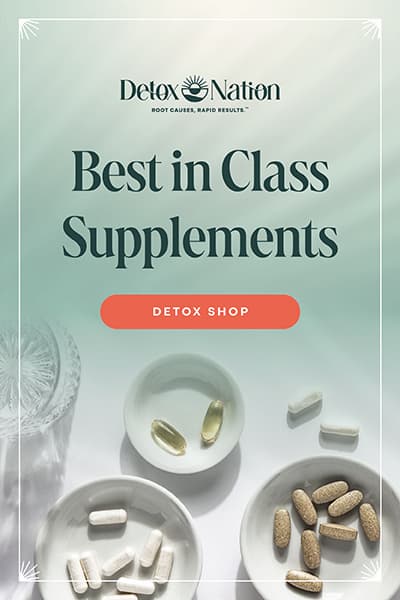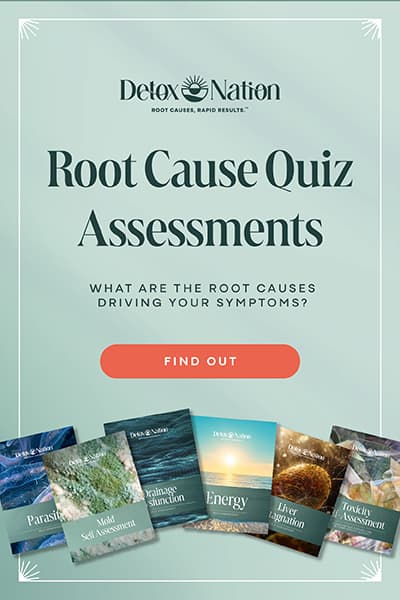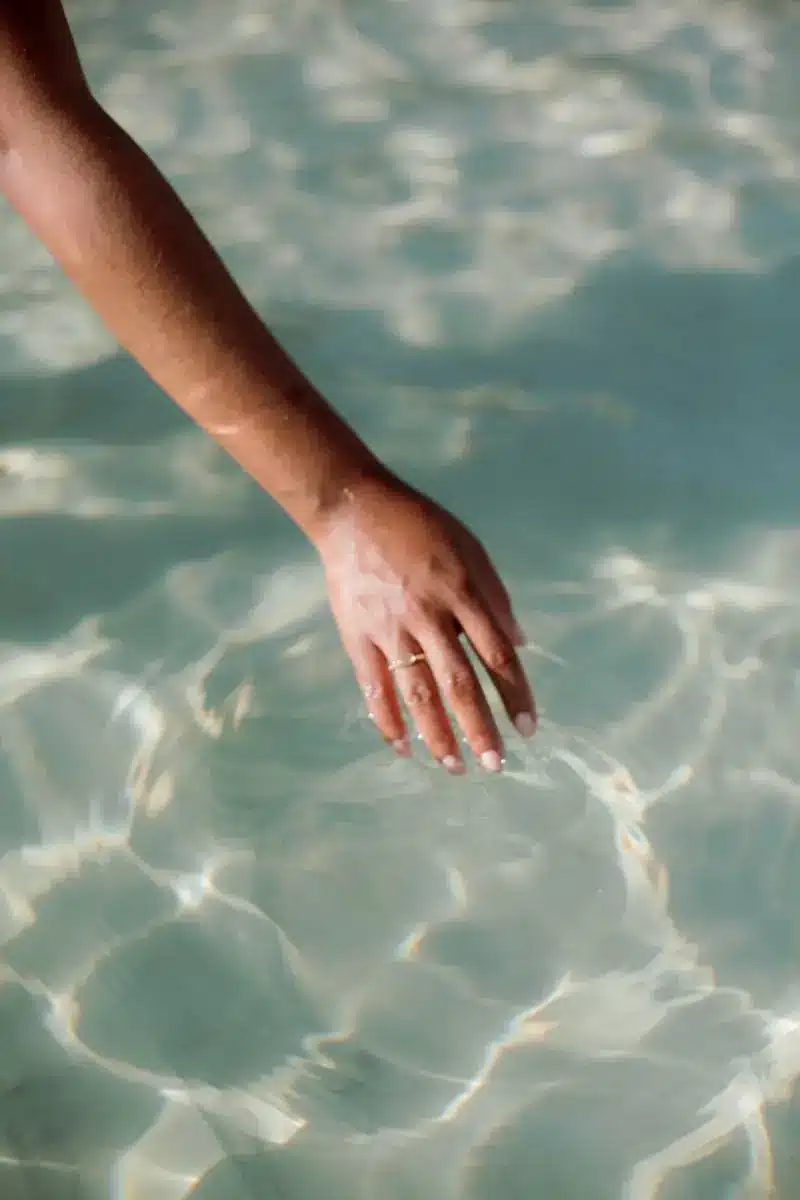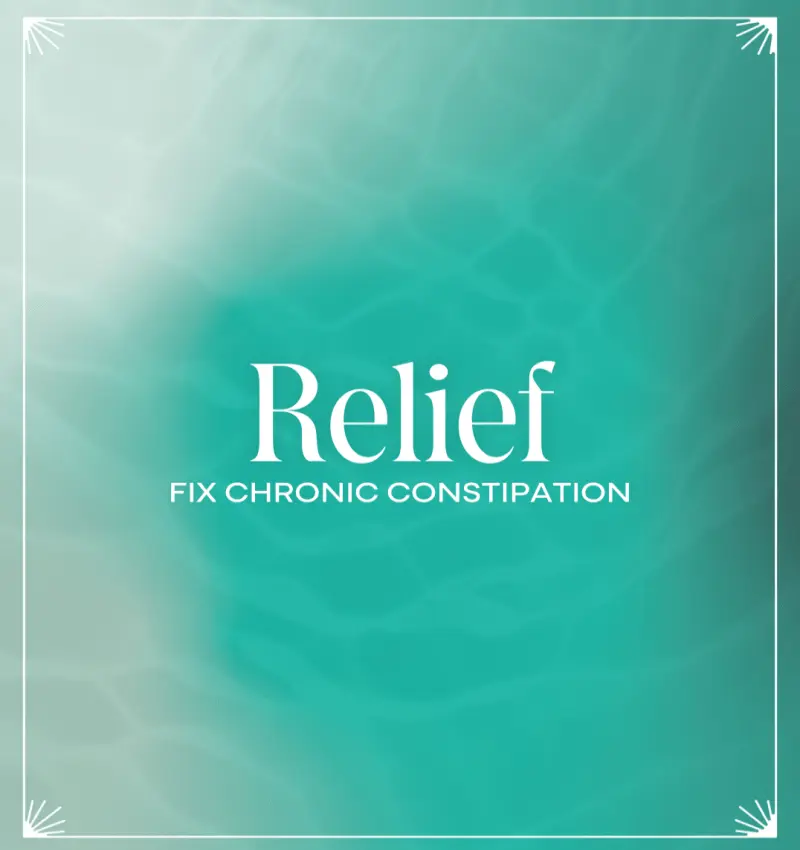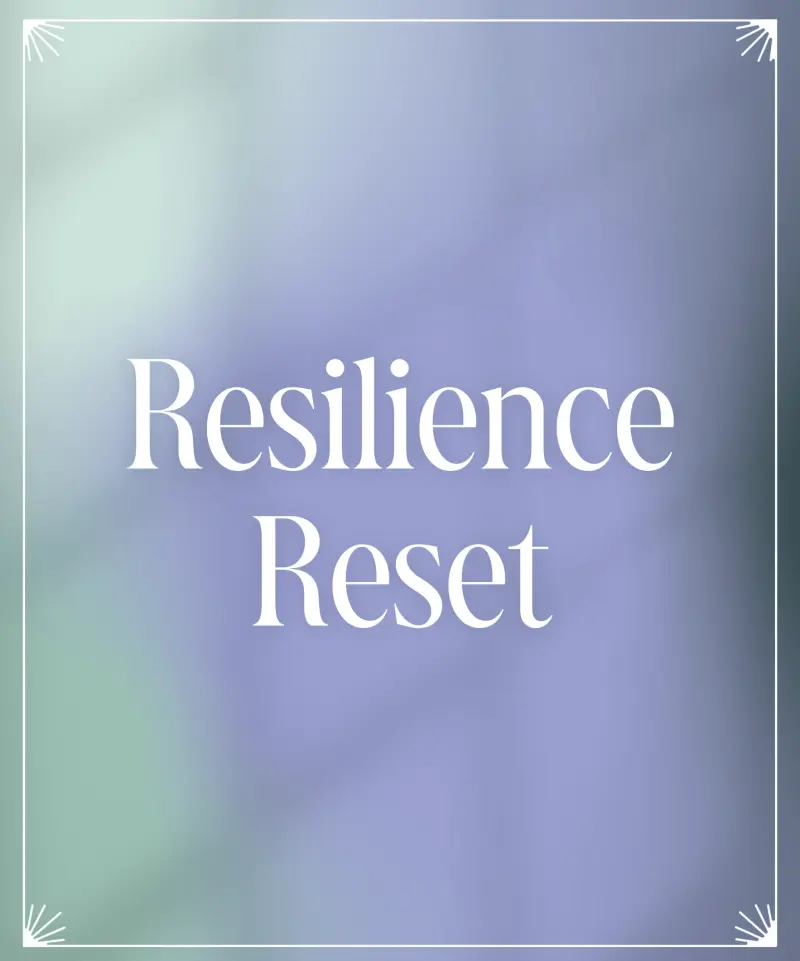Most tap water in the U.S. contains hidden water contaminants like heavy metals, pesticides, and pharmaceuticals — far beyond what “safety standards” pretend to cover. Know what’s really in your drinking water.
Imagine pouring yourself a glass of crystal-clear water, thinking you’re doing something good for your body — only to find out it’s spiked with fertilizer runoff, pharmaceutical residues, and enough chlorine to rival a swimming pool. No warning label.
No heads-up. Just business as usual.
It’s not your fault; you didn’t sign up to drink a cocktail of mystery chemicals every day.
And yet, here we are — living in a world where “clean drinking water” often means legally allowable levels of lead, pesticides, and even birth control hormones (7, 13). (Yep, those studies showing estrogen residues in tap water aren’t some fringe conspiracy — they’re right there in the research.
You deserve to know what’s in your water, how it got there, and what you can do about it — without getting sucked into an endless Google doom-scroll.
In this guide, we’re going to break it down step-by-step:
- How all these water contaminants sneak into your water supply
- What they do to your health (spoiler: it’s not just gut trouble and skin breakouts)
- Why distilled water (done right) beats the pants off most other options
Grab a big glass of actual clean water (or at least pretend for now) — let’s get you equipped.
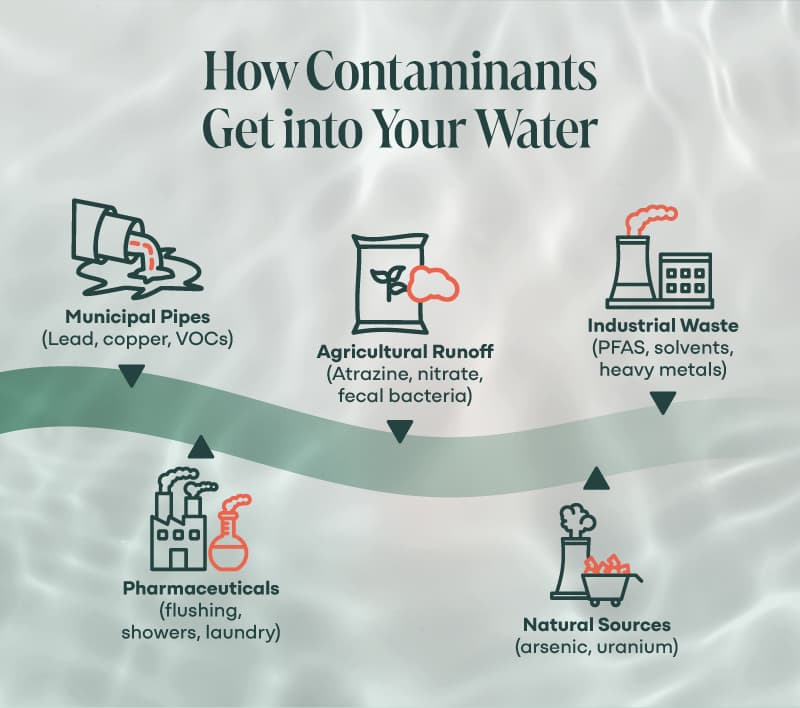
How Contaminants Sneak Into Your Drinking Water
If you ever thought the water coming out of your tap was safe just because it’s “regulated,” I hate to break it to you — regulations often prioritize what’s cheap and easy, not what’s healthy.
Water contaminants find their way into drinking water from just about every direction. Here’s how it really happens:
Municipal Infrastructure Failures
Many U.S. cities are still using pipes laid down before World War II.
Lead, copper, and PVC pipes slowly degrade. This corrosion of household plumbing pipes leaches metals and industrial chemicals straight into your cup (33).
(The whole “Flint, Michigan” situation? Not an isolated freak event — it’s happening in hundreds of places right now.)
Agricultural Runoff
Every time it rains, fertilizers, pesticides, and human or animal waste wash off fields and make their way into rivers, lakes, surface and ground waters — the same sources many cities use for drinking water (33).
That’s why you’ll find chemicals like atrazine (a banned herbicide in Europe) still showing up in U.S. tap water today.
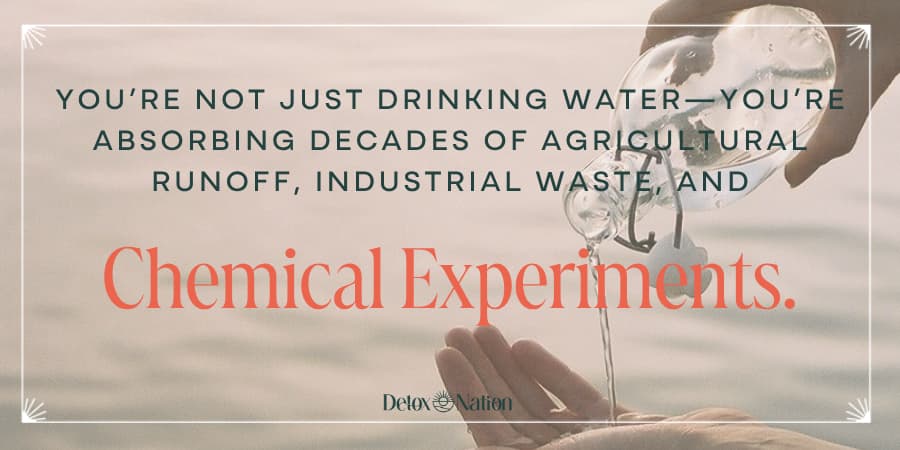
Industrial Waste Dumping
Factories love to quietly release chemical water contaminants such as solvents, heavy metals, and forever chemicals like PFAS into the air or nearby water supplies — legally or illegally (34).
(Fun fact: There are still places where you can legally dump “acceptable amounts” of carcinogens into public waterways, based on outdated “acceptable risk” math from the 1960s.)
Pharmaceutical and Personal Care Products
It’s not just your neighbor’s expired antibiotics getting flushed down the toilet.
Pain relievers, chemotherapy agents, psychotropic medications, statins, hormones, blood pressure medications, radionuclide contrast materials, and the list goes on and on.
In addition, every time you wash your hands, take a shower, or flush, tiny residues from soaps, shampoos, lotions, and medications flow into wastewater (7, 13).
Our treatment plants aren’t designed to filter most of that out — so it comes right back around, recycled into your “clean” tap water.
Naturally Occurring Toxins
Not everything is manmade.
Some areas have naturally high levels of arsenic, uranium, or radon in their groundwater (radiological water contaminants) — but “natural” doesn’t mean harmless.
Chronic low-level exposure to arsenic, for example, is a major risk factor for bladder and skin cancers.
If you’re feeling overwhelmed reading this — good. That means you’re awake.
But also know: you’re the kind of person who takes this information and does something with it.
This isn’t about fear — it’s about strategy. Let’s keep going.
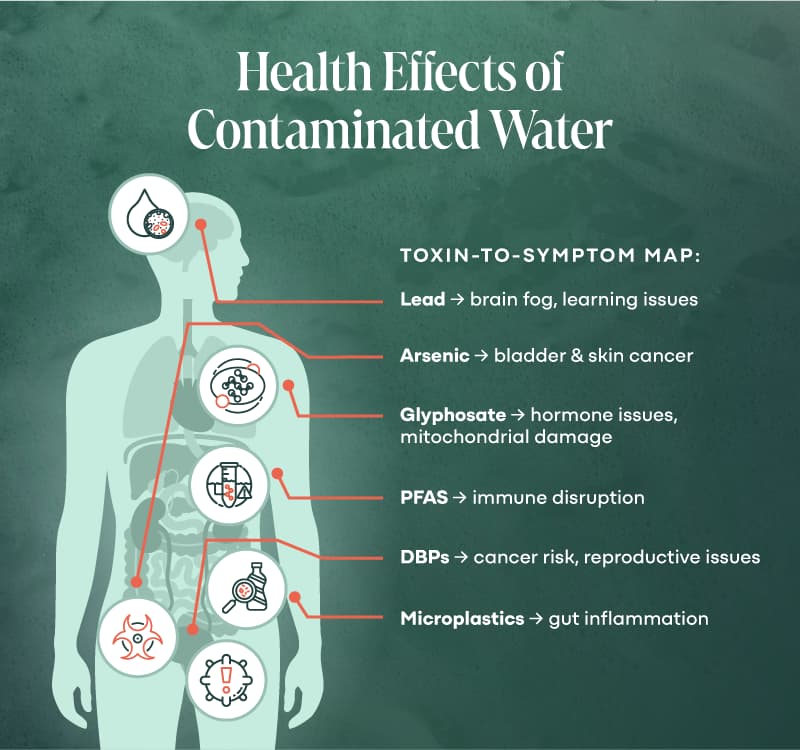
Main Classes of Drinking Water Contaminants and Their Health Impacts
The problem isn’t just that there’s “stuff” in your water — it’s that there are whole categories of nasty players, each with their own way of jamming up your body’s healing systems.
And thinking about how they interact with each other is enough to make you break out in a cold sweat.
Let’s review it together — like a scrappy health detective pulling out the real suspects.
How We Can Help
Guiding people to reclaim their health and vitality is our greatest joy. Our entire practice is dedicated to supporting you to be who you really are, at home in your body, because your body is able to heal itself.
Book A CallHeavy Metals: Arsenic, Lead, Cadmium, and More
Lead, arsenic, mercury, and cadmium are the usual troublemakers here.
Lead sneaks in from old pipes and causes brain fog, fatigue, and — not to be dramatic — cognitive decline.
Arsenic is even sneakier: it can hide in groundwater and quietly raise your cancer risk over the years (14).
And mercury? It’s a mitochondria-wrecker. If you’re exhausted for “no reason,” mercury deserves a closer look.
Pesticides & Herbicides
Looking at you, glyphosate and atrazine (7, 11).
These chemicals wash off farmland every time it rains, head straight into your water supply, and play games with your hormones, immune system, nervous system, reproductive system, and energy production (11).
Glyphosate especially, has been linked to mitochondrial dysfunction — meaning it can slow down your energy engine until you’re dragging through your days wondering if you’re just “getting older.” (32)
It’s not age — it’s exposure.
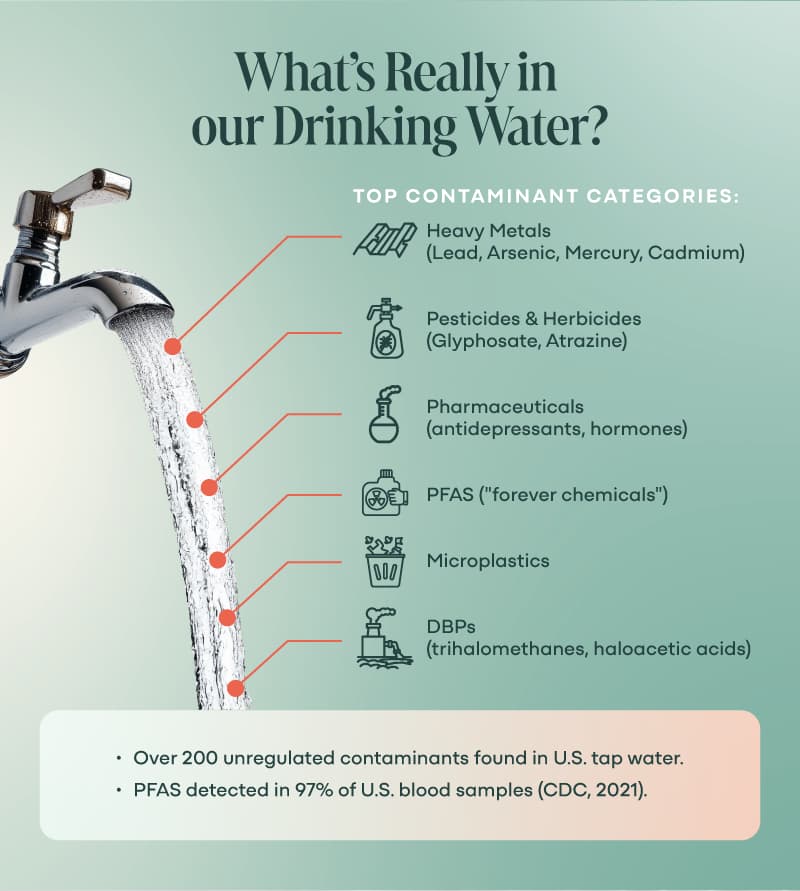
Microbial Water Contaminants (Hello BUGS)
This category includes things like Giardia, Cryptosporidium, and E. coli (36, 37)
These aren’t just a third-world problem; they show up in U.S. drinking water more often than most people realize, especially after heavy storms or sewer system leaks.
They even have a category for “emerging contaminants” – those microbiological water contaminants we aren’t aware of yet!
If you’ve ever had unexplained gut problems that just wouldn’t quit, there’s a real chance a sneaky bug from your water supply helped set up shop.
Chronic low-grade infections can keep your immune system stuck in survival mode without you even realizing it.
Pharmaceuticals
And then, because the universe has a wicked sense of humor, there are medication residues (7, 13).
Imagine tiny doses of antibiotics, antidepressants, and birth control hormones swirling invisibly in your water glass.
I should also tell you it’s not just prescription drugs. Even illegal drugs like meth, ecstasy, and cocaine can find their way into the water supply (13).
Wastewater treatment plants aren’t designed to catch them — so they flow right back into the ecosystem, and right into you.
Over time, these pharma leftovers can mess with your microbiome, stress your liver, and trigger hormonal imbalances that leave you feeling out of sync.
Disinfection Byproducts (DBPs)
One of my personal favorites in the “you’ve got to be kidding me” category.
These form when chlorine (meant to kill pathogens) reacts with organic material in water (5, 7).
In other words, even when cities try to clean the water, they accidentally create new toxins — like trihalomethanes and haloacetic acids — that are straight-up carcinogenic.
Oxidative stress, neurotoxicity, carcinogenesis, reproductive issues… It’s all documented (7).
Even worse, one researcher stated: “there are many more DBPs than typically covered by chemical analysis, and we do not even know how many there really are” (7).
So yeah, that “refreshing” glass of city water isn’t the safe bet it was cracked up to be.
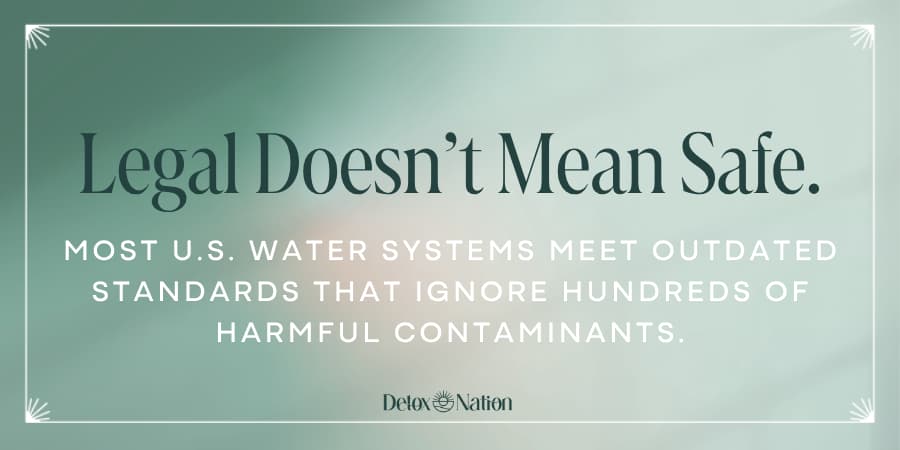
Industrial Chemicals and PFAS
This includes per- and polyfluoroalkyl substances (those “forever chemicals” you keep hearing about).
They’re in nonstick pans, waterproof clothing, fire-fighting foams — and now they’re in nearly every American’s blood.
PFAS don’t break down in the environment or the body, and they’ve been linked to immune system dysfunction, hormone chaos, and cancer.
Spoiler: they’re in most public water systems (7, 34).
A 2021 Environmental Working Group report found tap water in all 50 states contained measurable levels of PFAS, even in rural areas.
These aren’t just urban problems. If you’ve got pipes, you’ve got problems.
Microplastics
As if all that wasn’t enough, microplastics have entered the chat. These tiny fibers and fragments — invisible to the naked eye — show up in your faucet, bottles, rainwater, snow… pretty much everywhere now (7, 28, 31).
They’re not just inert junk either.
Microplastics can trigger gut inflammation, oxidative stress, and act like mini-trojan horses, soaking up pesticides and heavy metals and delivering them deeper into your body (28, 31).
(And no, your Brita filter isn’t catching them.)
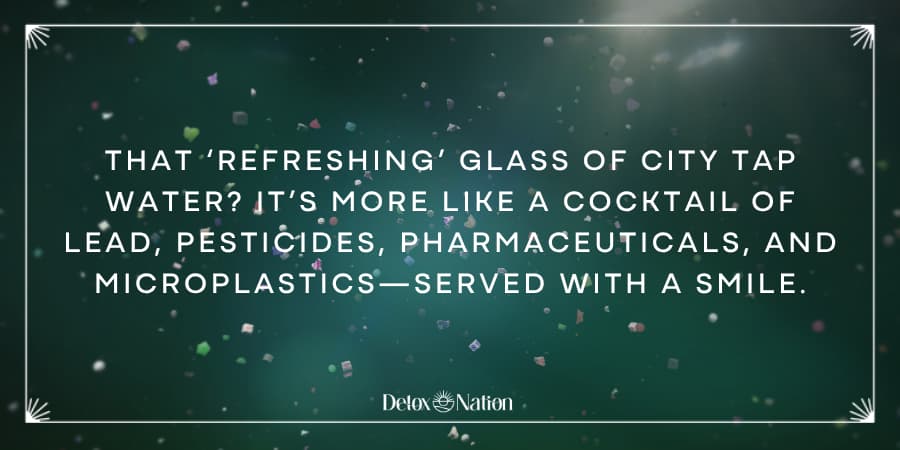
Volatile Organic Compounds (VOCs)
Finally, let’s talk about the sneakiest players: volatile organic compounds (VOCs).
These water contaminants include things like benzene, toluene, and xylene — chemicals that come from gasoline spills, industrial solvents, paints, and glues (39, 40).
VOCs don’t stay put.
They’re gases, meaning they evaporate easily, sneak into your water, and then into your lungs when you shower or cook (38).
Long-term, they’re linked to liver damage, kidney disease, and — you guessed it — higher cancer risk.
The worst part?
You can’t smell or taste VOCs in water, and most basic filtration systems don’t catch them. Even distillation needs an extra step (more on that soon) to really clear them out.
If all of this feels like a lot, that’s because it is a lot.
Modern water is basically the Wild West of chemical exposure.
Let’s make it even more personal:
- Struggling with thyroid issues? Fluoride and perchlorate exposures can be thyroid disruptors.
- Can’t lose the bloating or histamine issues? Chloramine can inflame your gut lining.
- Dealing with brain fog or depression? Heavy metals like lead, mercury, and copper can affect neurotransmitter function and mitochondrial health.
- Have mold illness? Drinking unfiltered water with microbial fragments or residual mycotoxins can worsen your symptoms—and keep your nervous system on red alert.
But the good news? You don’t need to fix everything overnight.
You just need to know what you’re up against — and how to stack the odds back in your favor.
Next up, we’ll get into why distilled water (with a few smart tweaks) can be a total game-changer for your healing.
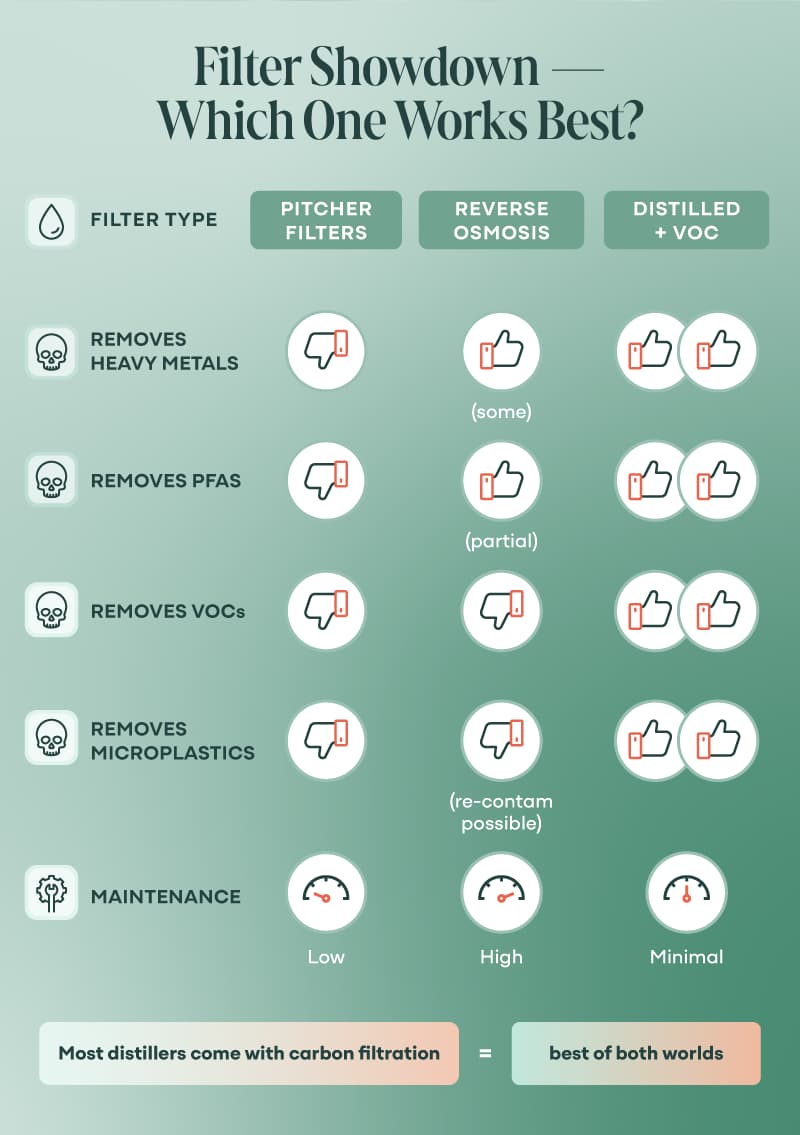
Distilled Water vs. Reverse Osmosis — Which Is Better?
Alright, now that you know your faucet doesn’t provide the healing elixir it’s supposed to, let’s talk solutions — specifically, the two big contenders: distilled water and reverse osmosis (RO).
You might already have a reverse osmosis system — or you might be Googling late at night, wondering if it’s worth dropping hundreds (or thousands) of dollars to install one.
I’ve been there too — squinting at comparison charts like my life depended on it, trying to figure out if my water would finally be safe enough.
Here’s what I wish someone had told me earlier:
Reverse osmosis is not perfect.
RO systems push water through a semi-permeable membrane, filtering out a lot of junk: heavy metals, fluoride, some pesticides (4, 5, 6, 13, 19, 20, 24, 27, 30).
It might be better than drinking straight tap water.
But — and it’s a big but — RO doesn’t remove everything.
Tiny water contaminants like some pesticides, solvents, and volatile organic compounds (VOCs) can slip through.
While RO can separate microplastics from water, teeny defects in the membranes or pipes can return microplastics to the filtered water (28).
Plus, most RO systems need regular maintenance, filter changes, and pressure checks — and if you don’t stay on top of it like a full-time water manager, the quality drops fast.
Distilled water, when done right, is a different game.
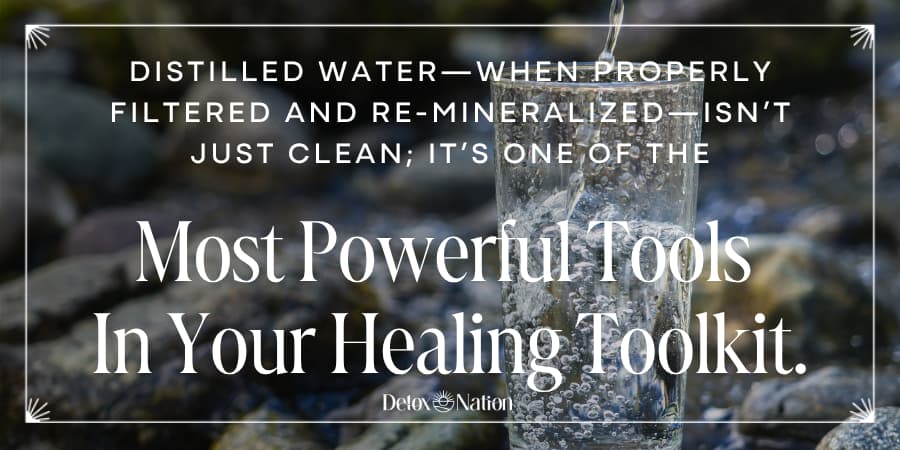
Distillation is simple: you boil the water into steam, collect that steam, and leave almost everything else behind — heavy metals, microplastics, bacteria, parasites, and most chemical residues (6, 10, 29, 30).
Add some minerals back in, and you’re good to go!
It’s like hitting a “reset” button for your water.
And unlike RO, there’s no membrane to clog, no pressurized tank to babysit.
Once you set up a good distiller, it’s just you and your fresh, clean water.
That’s why, for people like us — people trying to unburden their bodies from chronic stress, toxic load, and mystery symptoms — distilled water isn’t just a nice upgrade. It’s a lifeline.
Here’s my favorite brand. (You’re welcome!)
Reality Check: The VOC Caveat
Now, because you’re smart and paying attention (I see you), here’s the full truth: distillation removes most water contaminants, but it alone doesn’t automatically remove all volatile organic compounds.
VOCs have low boiling points — meaning they can evaporate along with the water vapor and sneak into your final product.
If you’re serious about clean water — there are three simple ways to fix this:
- Use a distiller with a built-in carbon post-filter designed to grab VOCs before the water drips into the collection container.
- Or add a secondary carbon filtration step after distillation — easy, affordable, and massively effective.
- Dispose of the first half-pint of water
Yes, it’s one extra step.
But honestly? Healing your body in today’s world requires extra steps.
I’ll take an extra five minutes a month to swap a carbon filter if it means my nervous system isn’t constantly battling benzene fumes.
And compared to the stress of wondering whether your “filtered” water is secretly slipping microplastics or hormone disruptors into your cells?
Re-mineralized distilled water is still the hands-down winner.
Quick Recap: Why Re-mineralized Distilled (with a VOC trap) Wins:
- Removes nearly all heavy metals, parasites, bacteria, viruses, PFAS, microplastics, and most chemicals
- Reduces VOCs with a simple carbon step
- Minimal maintenance compared to RO
- No mystery filter breakdowns or pressure failures
- Gives your body the clean slate it’s been asking for
Now that you know where real clean water starts, let’s talk about what you can do today — without needing a chemistry degree or a million-dollar water system.
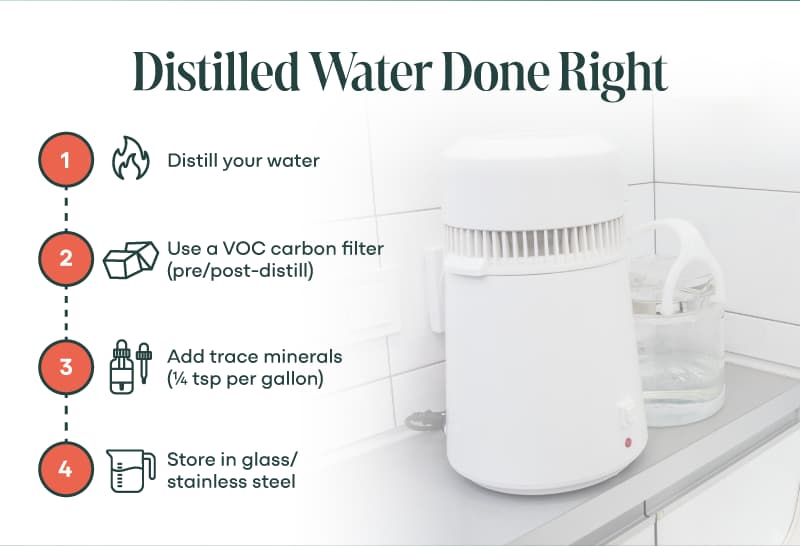
Practical Tips to Reduce Your Exposure Right Now
Look — I get it.
You don’t have time to turn your house into a water lab.
You just want to know what simple moves you can make right now to protect your health without getting sucked into a black hole of overcomplicated solutions.
Good news: Protecting yourself from water contaminants doesn’t have to be complicated. It just must be consistent.
Here’s where to start:
Start Drinking Distilled Water — Ideally with a VOC Filter Built-in.
If you haven’t already, make the switch. (Here’s the link to my favorite brand.)
A countertop distiller with a carbon post-filter gives you some of the cleanest, safest water available without breaking the bank.
You don’t have to overthink this — even the simpler home models work beautifully if you’re willing to maintain them (read: clean it when it gets gunky, swap out that carbon filter every few months).
If a distiller feels like a big purchase today, start small: grab glass jugs of distilled water from a trusted store while you save up for your own setup. Progress beats perfection every single time.
Store Your Clean Water The Right Way.
Plastic is a no-go.
It leaches endocrine disruptors (especially when the sun hits it, or it heats up).
Use glass or stainless steel containers with tight-fitting lids instead. And yes, you’ll feel ridiculously fancy pouring your drinking water from a massive glass jug — but you’ll also be way healthier for it.
Don’t Cook with Tap Water.
Here’s a sneaky source of extra exposure: when you boil tap water, you concentrate the water contaminants, because the water evaporates but the toxins stay behind (29).
So, if you’re making soup, pasta, rice, or tea, cook with distilled (or fully filtered) water instead.
Don’t Forget about Your Skin.
Your skin drinks too.
Unfiltered shower and bath water = daily chemical exposure.
Invest in a good shower filter that handles chlorine and VOCs — it’s a simple install, doesn’t cost much, and makes a big difference. (Your skin and lungs will thank you.)
If you’re super sensitive, consider a whole-house filter eventually — but honestly, even just filtering your drinking and shower water gets you miles ahead of where most people are.
Clean Your Containers and Distiller Regularly.
Just because your water starts clean doesn’t mean it stays clean if you store it wrong.
Give your jugs and distiller a regular rinse with a little vinegar or baking soda to keep biofilm and bacteria from setting up camp.
Think of it like brushing your teeth — boring but necessary maintenance that saves you way bigger headaches down the road.
Stay Nosy about Your Local Water Report
Most cities are required to publish annual water quality reports.
They’re worth reading… but don’t assume they tell the whole story.
Many “allowable” contaminant levels are shockingly high, and some water contaminants aren’t even legally required to be reported yet (looking at you, PFAS).
If something feels off — strange tastes, smells, or you just have a hunch — trust yourself. Your body is smarter than any government report.
And you’re way too smart to keep drinking contaminated water and calling it “normal.”
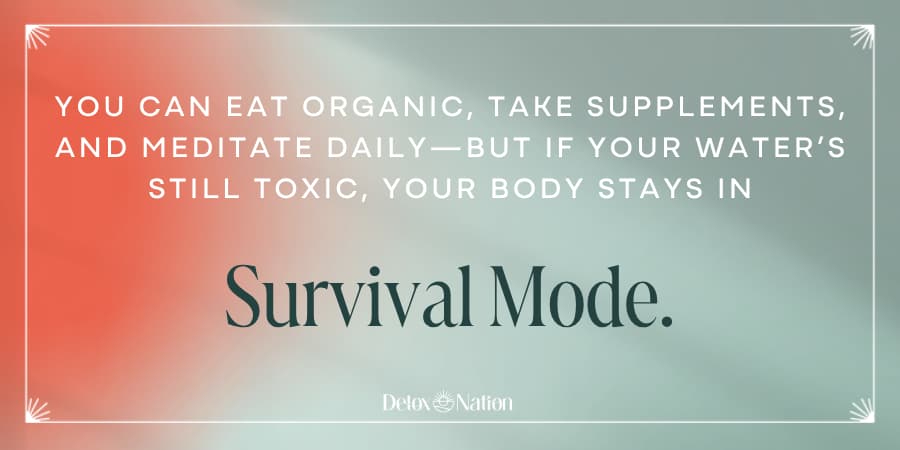
Bigger Picture — Why This Matters for Your Healing Journey
Here’s the thing most practitioners won’t tell you:
You can take all the supplements, eat all the organic kale, meditate yourself into a peaceful puddle — but if you’re still drinking contaminated water every day, your body is stuck playing defense.
Chronic exposure to heavy metals, pesticides, and microplastics keeps your system in a low-grade stress response, constantly battling threats instead of repairing tissues, restoring energy, or regulating your hormones.
Water isn’t just another thing on your wellness checklist. It’s your most essential input.
Every cell, every organ, every biochemical process in your body relies on water to function — clean, unburdened water.
When you switch to clean water, you’re not just hydrating better.
You’re finally giving your body the break it’s been begging for — the chance to shift from survival mode back into healing mode.
You’re clearing the noise so your gut can repair, your brain can think clearly, your mitochondria can pump out energy like they were designed to, and your nervous system can rest.
Clean water isn’t a luxury.
It’s the starting line for reclaiming your resilience — physically, emotionally, spiritually.
You’re in Charge — And That’s Good News
If you’ve made it this far, you already know more about drinking water contaminants than 99% of the population.
(Seriously — most people still think the little chlorine smell in their tap water means it’s “extra clean.” Bless.)
You know how water contaminants sneak in. You know how they can quietly drag down your energy, your gut, your focus, your future.
And you know that real solutions — simple, practical ones like drinking distilled water and storing it safely — are completely within your reach.
You don’t need a government agency to save you.
You just need to keep stacking small wins. One jug of clean water at a time. One conscious choice at a time.
Because when you set the right conditions — when you remove the burden instead of just managing the symptoms — your body knows exactly what to do.
It remembers how to heal. It wants to heal.
Clean water isn’t just about what you’re avoiding.
It’s about what you’re making room for: energy, vitality, clarity, resilience, real healing.
You’re the CEO of your health — and today, you just made a major executive decision.
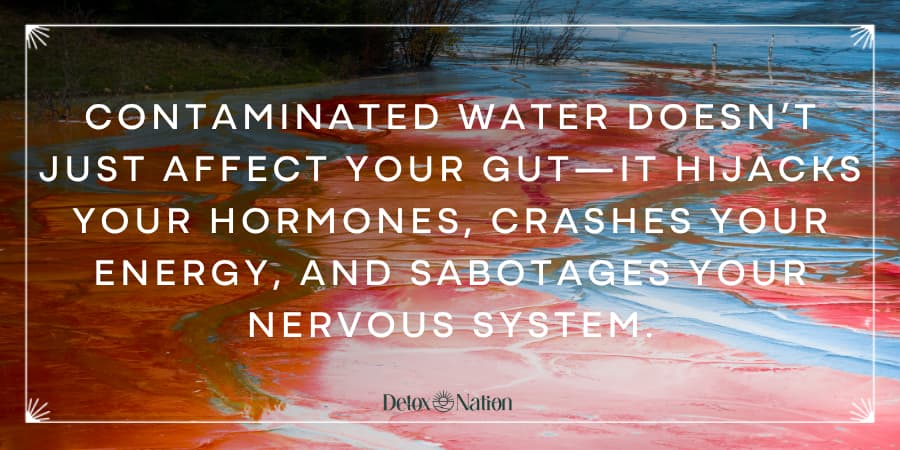
FAQs
1. Is tap water in the U.S. really that bad?
Short answer: yep. Even “legal” levels of water contaminants like lead, PFAS, and medication residues are linked to serious health issues. Legal ≠ safe.
2. What’s the biggest problem with drinking regular tap water?
It’s the cumulative load — heavy metals, pesticides, microplastics, and VOCs stacking up inside your body every day, overwhelming your detox and repair systems. Water contaminants may cause health effects due to the chronic, cumulative, and stacked exposures.
3. Can’t I just use a Brita or basic water filter for safe drinking water?
Unfortunately, no. Basic filters only remove chlorine taste and a few sediments. They leave most heavy metals, per- and polyfluoroalkyl substances, medications, and VOCs untouched.
4. What water contaminants does distillation remove?
Distillation removes almost everything: heavy metals, parasites, bacteria, microplastics, per- and polyfluoroalkyl substances, and most chemicals. It’s like a “factory reset” for your water.
5. What about VOCs — can distillation miss those?
Distillation can miss some VOCs unless you add a carbon post-filter or use a distiller with one built in. (Easy fix, totally worth it.)
6. What’s wrong with reverse osmosis systems?
RO is better than unfiltered, but it doesn’t catch all water contaminants, especially some chemicals and VOCs. Plus, it needs high maintenance to stay effective.
7. Do I need to store distilled water a special way?
Yes! Always use glass or stainless steel containers. Plastic can leach chemicals into even the cleanest water, especially if it sits in sunlight or heat.
8. Should I also filter my shower water?
Absolutely. Your skin absorbs water contaminants, and VOCs can vaporize in your shower steam. A good shower filter is a small move with a big impact.
How We Can Help
Guiding people to reclaim their health and vitality is our greatest joy. Our entire practice is dedicated to supporting you to be who you really are, at home in your body, because your body is able to heal itself.
Book A Call




